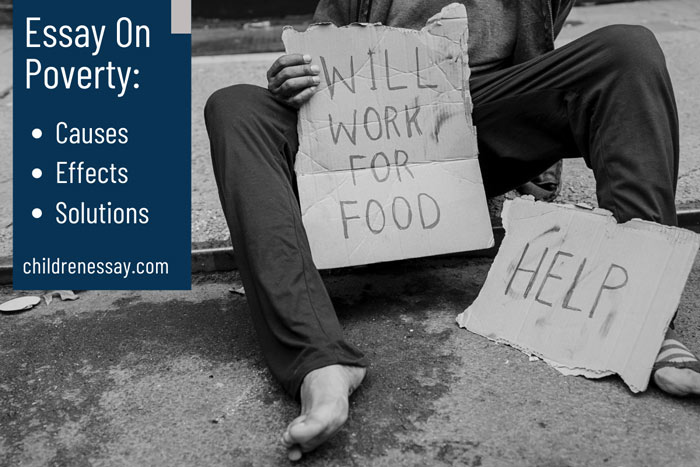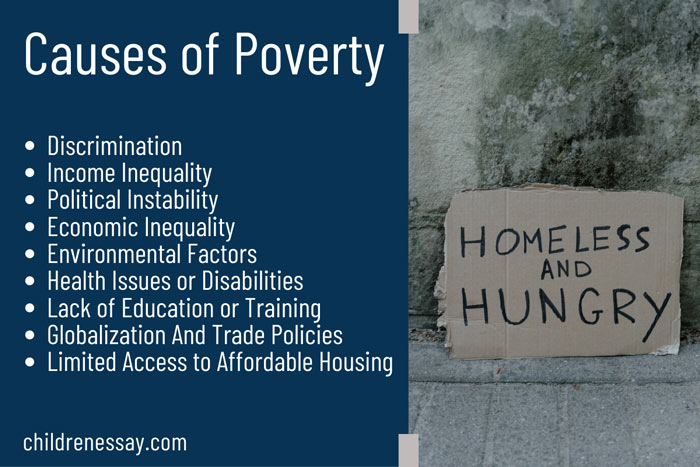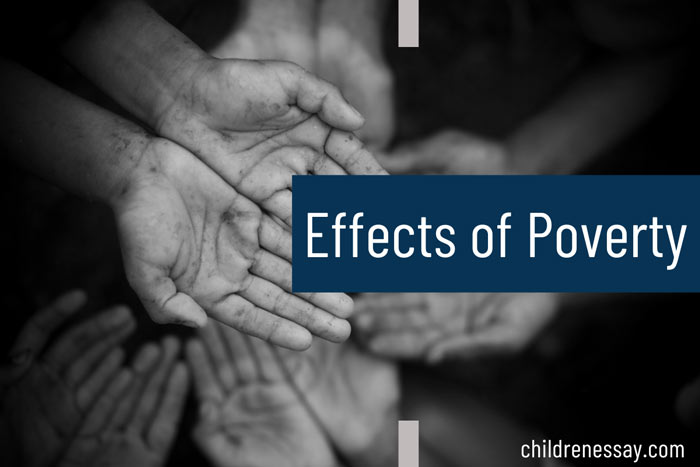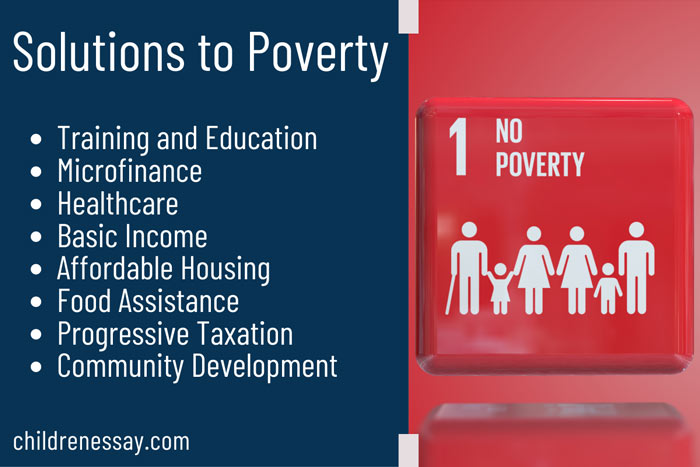Poverty is an international problem that affects many people. It means not having enough money for basic things like food, housing, and healthcare. Poverty also has serious consequences for individuals and communities. In this essay on poverty, we will examine the causes, effects, and possible solutions to poverty. Understanding poverty better will enable us to create a more equal society where everyone can live happily.

Table of Contents
Introduction to Poverty Essay
A person who is in poverty is one who lacks basic necessities like food, shelter, and clothing. It’s a complex, broad issue that affects millions of people worldwide. But poverty isn’t just a lack of material resources; it’s also a range of social, economic, and political factors that limit an individual’s freedom.
A person in poverty may experience poor health outcomes, limited access to education, higher crime rates, and social exclusion. Poverty impacts society as a whole as well, including lower economic productivity, higher healthcare costs, and increased social inequality.
In many cases, poverty is tied to other forms of inequality, like racism, sexism, and disability discrimination. These overlapping factors make it difficult for individuals and communities to break out of poverty. Even though poverty has been combated for decades, it remains a big problem everywhere. In fact, the COVID-19 pandemic has made it worse, pushing millions of people into poverty.
In order to solve poverty, it’s important to understand its root causes and effects of poverty and develop effective strategies.
Also Read: Essay On Motivation In Life.
Causes of Poverty: Examining Systemic and Individual Factors Contributing to Poverty

Economic Inequality
The presence of large amounts of wealth in the hands of a few individuals or groups can limit the access of those who are not as fortunate to have access to resources and opportunities. For example, families with low incomes may not be able to afford the same quality of education as wealthy ones, thus limiting their future opportunities.
Political Instability
A country with an unstable political climate may have limited access to basic services such as healthcare and education, leading to higher poverty rates. According to the World Bank, 8% of the global population, or 648 million people, live in extreme poverty.
Discrimination
Access to resources and opportunities can be limited by societal barriers like race, gender, sexuality, or ability. These kinds of barriers can be seen in education, employment, housing, and healthcare. They create an unequal playing field, where some have access to resources, while others are unfairly excluded. Due to this, disadvantaged people are unable to break out of poverty.
Lack of Education or Training
It is a major cause of poverty. When people don’t have access to appropriate education or vocational training, they often can’t get well-paying jobs or find employment at all. Without education, it’s hard for individuals to escape poverty because they lack the skills and knowledge needed to secure better opportunities.
Health Issues or Disabilities
Individuals with health issues or disabilities may be unable to work or earn a stable income due to health issues or disabilities. Healthcare costs can quickly increase, putting individuals under financial burden. Also, individuals who suffer from health challenges may have difficulty finding and maintaining employment due to limited physical or cognitive abilities. Lack of access to healthcare and preventative services worsens the problem. Health issues and disabilities impact economic stability and basic needs, creating a continuous cycle of poverty.
Limited Access to Affordable Housing
When people cannot find affordable housing, they must spend a large portion of their income on housing, leaving them with only a minimal amount of money to spend on other basic necessities. This problem is caused by factors such as high prices, limited availability, and discriminatory practices, which lead to overcrowded and unhealthy living conditions, evictions, and homelessness.
Globalization And Trade Policies
Globalization and trade policies can lead to poverty for several reasons. When countries engage in globalization and trade, local industries can suffer because they are unable to compete with foreign companies. It can result in job losses and the loss of economic diversity within the country.
Also, trade policies that do not properly regulate cheap goods can negatively impact developing countries. If powerful nations favor these goods, it can lead to overdependence on imports, further diminishing local industries and job opportunities. Also, trade agreements may prioritize the export of raw materials rather than encouraging the development of industries that add more value to these resources.
Developing countries also face challenges related to technology, medicine, and labor standards. Limited access to advanced technologies and essential medicines can interfere with their development. Also, outsourcing production to countries with lower labor standards can lead to low compensations and poor working conditions for workers in developing countries.
In short, trade policies that prioritize profit over people can lead to job loss and lower wages, contributing to poverty in both developed and developing countries.
Environmental Factors
Environmental factors also cause poverty. There are also natural disasters like droughts and floods that destroy livelihoods and limit access to resources like fertile land and water. Rising temperatures and unpredictable weather patterns have also been linked to climate change, which affects both agriculture and low-income communities. Deforestation and pollution further damage people’s health by reducing access to resources. Polluted areas or toxic waste dumps further worsen the situation for underprivileged communities.
Income Inequality
Income inequality is one of the key causes of poverty. Poverty occurs when there is an imbalance in the distribution of income within a society, with some holding large amounts of wealth while the majority struggles with low incomes. There are several factors that can contribute to inequality, including unequal access to education, a lack of employment opportunities, as well as unfair economic policies. It contributes to a cycle of poverty by preventing people from getting decent salaries, accessing essential resources, and improving their overall living conditions, thus widening the wealth gap.
Also Read: Should Teenagers Have a Part Time Job Essay.
Effects of Poverty: Short Term and Long Term
Individuals in poverty lack the resources they need to meet their basic needs. Here in this poverty essay, we will analyze the short-term and long-term effects of poverty.

Short-term Effects of Poverty
- Malnutrition:Poverty leads to a lack of access to nutritious food, resulting in malnutrition, which can cause inadequate growth, weakened immune systems, and other health problems.
- Poor Health:People living in poverty often lack access to healthcare and basic hygiene, leading to an increased risk of diseases and poor health outcomes.
- Lower Educational Achievement:Children living in poverty often lack access to quality education, leading to lower levels of education, which can have negative effects on future employment opportunities and earning capacity.
- Increased Crime Rates: The higher the level of poverty is, the more likely it is that people will become dependent on committing crimes in order to meet the basic needs of their families.
- Psychological Distress:Poverty can also cause psychological distress, including feelings of shame, anxiety, and depression.
Long-term Effects of Poverty
- Reduced Earning Potential:Poverty often results in lower education levels and limited opportunities for individuals growing up in poverty. A poverty-stricken individual may not have the same level of education or opportunities as an individual who grows up in a wealthy neighborhood.
- Poor Health Outcomes:People suffering from poverty over the long term are more likely to suffer from poorer health outcomes, including a higher rate of chronic diseases and illnesses.
- Intergenerational Poverty:There is a possibility that poverty may be passed from one generation to the next, thus creating a cycle of poverty that can be difficult to break.
- Limited Social Mobility: In some cases, poverty limits social mobility and makes it challenging for individuals and families to make progress on the road to economic success and achieve greater economic stability as a result of poverty.
- Reduced Community Development:When a community is poor, it often faces barriers to development due to the lack of available resources and opportunities for growth.
Also Read: What Does It Mean to Be Human Essay.
Effective Strategies and Solutions to Poverty
There are various potential solutions and interventions to reduce poverty, ranging from short-term emergency relief to long-term structural changes. Here are some solutions to poverty:

Training and Education
Training and education are vital strategies for addressing poverty. Providing people with the skills and knowledge they need can increase their chances of finding a job and earning a living. Investing in educational opportunities, including vocational training and job-specific skills development, can empower individuals to break the poverty cycle.
Also, financial awareness and entrepreneurship education can give people the tools to manage their finances effectively and earn money. We can help individuals improve their lives and contribute to the economic development of their communities by investing in training and education.
Microfinance
Microfinance is an effective strategy and solution for poverty that offers small loans and financial services to people who don’t have access to traditional banks. It allows low-income people to earn income and improve their lives by starting or expanding their own small businesses.
A microfinance institution also provides borrowers with financial education and support, allowing them to develop good financial habits and manage their resources effectively. By providing microfinance to people, they will have the opportunity to break out of poverty and become self-sufficient, and this plays a vital role in uplifting their communities and giving them hope for the future.
Healthcare
Health care plays an important role in addressing poverty by providing effective strategies and solutions. Providing accessible and affordable healthcare services is essential to improving personal well-being and combating poverty.
As a society, we are responsible for making sure everyone has access to quality healthcare, including preventive care, diagnostics, treatments, and medications, so that our people can stay healthy, pursue education, and find employment.
Also, healthcare initiatives that focus on the promotion of health education and disease prevention can help individuals and communities make informed decisions about their health, thereby reducing poverty in the long run.
Basic Income
The basic income program is meant to provide individuals with a regular, unconditional source of income to cover all of their basic needs, regardless of whether or not they work. Along with reducing poverty, this can also provide a safety net for people with disabilities or other reasons who cannot work.
Affordable Housing
Providing affordable housing is a key way to fight poverty and ensure everyone has a place to live. This involves developing affordable housing options for low-income families. People and families can pay for other necessities like food and health care if housing is more cost-effective.
Also, this approach prevents housing insecurity and lowers housing costs, which gives people the opportunity to get quality education and a job. Housing for everyone can be achieved through a range of measures, including government subsidies, rent control, and partnerships with non-profits.
Food Assistance
Food assistance is critical for fighting poverty. It helps people and families who can’t afford nutritious food. It can come in the form of food banks, government programs, or community initiatives. The benefits of food assistance include reducing hunger, improving health outcomes, and enabling students to pursue education, jobs, and other opportunities. The goal of food assistance is to reduce poverty by addressing one of the most fundamental needs of individuals.
Progressive Taxation
Progressive taxation is an effective strategy and solution to poverty that involves taxing individuals and businesses based on their income or wealth. With a progressive tax system, people with higher incomes or more wealth pay more in taxes, while people with lower incomes pay less. Through this approach, appropriate wealth will be redistributed and income inequality will be reduced, giving the government more money to invest in programs that help people out of poverty.
Community Development
The goal of community development is to empower and improve the lives of individuals within a community thereby reducing poverty. The main objective is to identify and address the root causes of poverty, such as limited access to education, healthcare, and employment opportunities, by bringing together community members, organizations, and resources.
A key objective of community development is to uplift and break the cycle of poverty by actively involving the community in decision-making processes, increasing collaboration, and implementing sustainable initiatives. By using this approach, communities can become more self-sufficient, adaptable, and equipped with the tools and support they need in order to overcome poverty and improve their overall well-being.
Also Read: Can A Person Choose to Be Happy Essay.
Conclusion of Poverty Essay
Poverty is a pressing global issue with severe consequences for individuals and societies. Several factors contribute to this problem, including limited access to education, limited resources, unemployment, and unequal distribution of wealth. The effects of poverty can be seen in the form of inadequate healthcare, malnutrition, crime, and instability in society. As a way to combat this problem, we should create jobs and start businesses, improve access to essential necessities like water and healthcare, and create social safety nets. If we address the root causes and implement sustainable solutions, we can make our society more balanced and economically successful.
